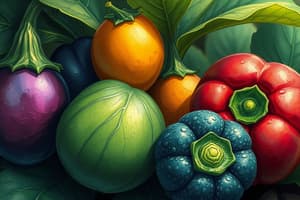Podcast
Questions and Answers
What are berries?
What are berries?
- Central seed containing fruits
- Fruits with a thick outer rind
- Small juicy fruits with skin (correct)
- Large juicy fruits
What type of fruits have outer skin covering?
What type of fruits have outer skin covering?
- Drupes (correct)
- Melons
- Berries
- Pomes
What defines pomes?
What defines pomes?
- Have a thick outer rind
- Have a central seed containing a core (correct)
- Have multiple seeds in the core
- Are large juicy fruits
Citrus fruits have which of the following characteristics?
Citrus fruits have which of the following characteristics?
What are tropical fruits?
What are tropical fruits?
Which of the following are classified as bulbs?
Which of the following are classified as bulbs?
What type of vegetables are represented by broccoli, cauliflower, and artichoke?
What type of vegetables are represented by broccoli, cauliflower, and artichoke?
What type of fruits are tomatoes and eggplants classified as?
What type of fruits are tomatoes and eggplants classified as?
Match the following with their respective terms:
Match the following with their respective terms:
What defines underripe fruits?
What defines underripe fruits?
What happens during enzymatic browning?
What happens during enzymatic browning?
What is a key benefit of cooking fruits?
What is a key benefit of cooking fruits?
What occurs during the cooking process of fruits?
What occurs during the cooking process of fruits?
What is the effect of cooking fruits in water?
What is the effect of cooking fruits in water?
What happens when fruits are baked?
What happens when fruits are baked?
What is the main method of cooking fruits that creates a caramelized texture?
What is the main method of cooking fruits that creates a caramelized texture?
Flashcards are hidden until you start studying
Study Notes
Classification of Fruits and Vegetables
- Berries: Small, juicy fruits with skin; examples include blackberries and blueberries.
- Drupes: Fruits with an outer skin covering; includes cherries, apricots, peaches, and nectarines.
- Pomes: Feature a central seed-containing core; common examples are pears and apples.
- Citrus Fruits: Characterized by a thick outer rind and a thin membrane that separates the fruit into sections.
Other Categories of Fruits
- Melon: Large, juicy fruits with thick skin and many seeds.
- Tropical Fruits: Grown in warm, exotic climates.
Types of Vegetables
- Bulb: Includes vegetables like garlic and onion.
- Flower: Comprises broccoli, cauliflower, and artichoke.
- Fruits: Vegetables like tomatoes, eggplant, peppers, pumpkins, and squash are botanically classified as fruits.
- Stem: Examples are celery and asparagus.
- Leaves: Includes lettuce, spinach, cabbage, and Brussels sprouts.
- Seeds: Comprised of peas, corn, and beans.
- Tubers: Potatoes fall into this category.
- Roots: Includes beets, carrots, parsnips, radishes, and turnips.
Potato Classification
- Potatoes are classified based on appearance and purpose:
- All-purpose: Good for baking and boiling.
- Baking: Russet potatoes, which break apart easily.
- New potatoes: Sent to market immediately after harvest.
- Round red varieties: Suitable for boiling, frying, and salads.
Nutritional Compounds in Vegetables
- Flavones: Found in white vegetables; are water-soluble and can darken if overcooked.
- Anthocyanin: Present in red vegetables; preserves their color when vinegar or lemon juice is added during cooking.
Cooking Techniques for Fruits and Vegetables
- Use minimal water to cook vegetables to retain nutrients; methods include:
- Simmering or steaming
- Baking (e.g., potatoes)
- Frying (sautéing, fritters)
- Broiling
- Microwaving
- Grilling
Fruit Ripeness
- Underripe Fruits: Fully sized but not at peak eating quality; example is a firm banana.
- Immature Fruits: Not fully matured; can appear small with poor color and texture; won’t improve at room temperature.
Enzymatic Reactions
- Enzymatic Browning: The darkening of fruits exposed to air; can be prevented by dipping in citrus juice (lemon, orange, grapefruit, or pineapple juice).
Cooking Fruits
- Cooking allows using overripe fruits; for instance, ripe bananas can be made into banana bread.
- During cooking, the following occurs:
- Cellulose softens for easier digestion.
- Color changes and heat-sensitive nutrients may be lost.
- Flavor becomes less acidic and more mellow.
- Adding water can help retain water-soluble nutrients.
Cooking in Liquid
- Cooking fruits in water will cause them to lose their shape.
- Cooking in sugar syrup (2:1 water to sugar) will help retain their shape when cooked at low temperatures.
Baking Techniques
- Baking fruits tenderizes them while maintaining their shape, particularly when baked in their skins.
Broiling and Grilling Fruits
- Fruits are cooked under direct heat, often sprinkled with sugar to create a caramelized texture; common examples include bananas and pineapples.
Frying Fruits
- Cooking fruits through deep frying is known as making fritters.
Studying That Suits You
Use AI to generate personalized quizzes and flashcards to suit your learning preferences.




